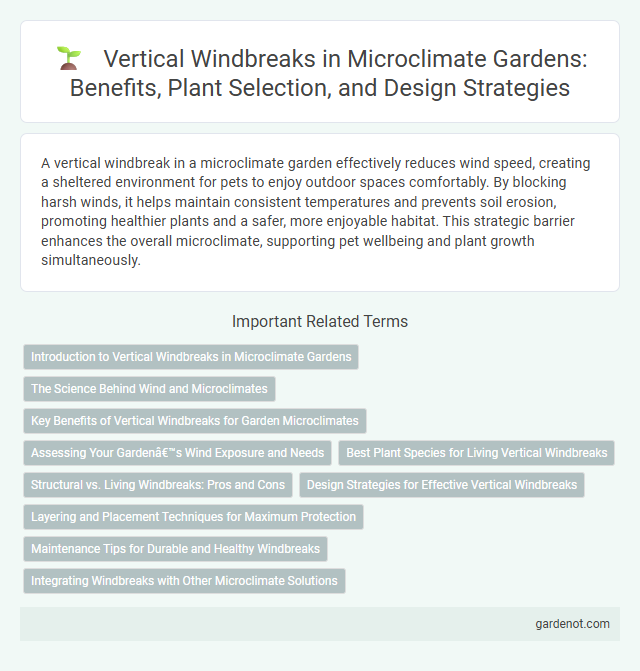A vertical windbreak in a microclimate garden effectively reduces wind speed, creating a sheltered environment for pets to enjoy outdoor spaces comfortably. By blocking harsh winds, it helps maintain consistent temperatures and prevents soil erosion, promoting healthier plants and a safer, more enjoyable habitat. This strategic barrier enhances the overall microclimate, supporting pet wellbeing and plant growth simultaneously.
Introduction to Vertical Windbreaks in Microclimate Gardens
Vertical windbreaks in microclimate gardens serve as strategic barriers that reduce wind speed, protecting plants from desiccation and mechanical damage. These structures, often composed of dense shrubs, trees, or constructed screens, create a more stable and favorable environment by moderating temperature fluctuations and conserving soil moisture. Implementing vertical windbreaks enhances plant growth and crop yields by optimizing airflow and minimizing the stress caused by harsh winds.
The Science Behind Wind and Microclimates
Vertical windbreaks alter airflow patterns by reducing wind speed and redirecting gusts, creating protected microclimates that mitigate plant stress and soil erosion. The scientific principles involve turbulent flow disruption and pressure differentials, which stabilize temperature and humidity levels within the sheltered zone. Studies show that strategically placed vertical structures can increase crop yields by enhancing moisture retention and minimizing desiccation in microclimate gardens.
Key Benefits of Vertical Windbreaks for Garden Microclimates
Vertical windbreaks enhance garden microclimates by reducing wind speed, which minimizes soil erosion and prevents moisture loss from plants. They create a sheltered environment that promotes healthier plant growth and extends the growing season by moderating temperature fluctuations. These structures also improve pollination efficiency and protect delicate plants from physical damage caused by strong winds.
Assessing Your Garden’s Wind Exposure and Needs
Evaluating your garden's wind exposure involves measuring prevailing wind directions and speeds using an anemometer or wind vane to identify vulnerable zones for plants. Understanding local wind patterns and seasonal variations helps determine the appropriate height and density of a vertical windbreak for effective protection. Incorporating native, wind-resistant vegetation or structural elements tailored to your garden's microclimate ensures optimal wind reduction and plant health.
Best Plant Species for Living Vertical Windbreaks
The best plant species for living vertical windbreaks include fast-growing evergreens like Leyland cypress, Eastern red cedar, and arborvitae due to their dense foliage and year-round wind resistance. Deciduous options such as silver maple and honey locust offer seasonal protection with their broad canopies while allowing airflow in winter to reduce snow build-up. Selecting native species adapted to the local microclimate enhances the vertical windbreak's effectiveness and sustainability for soil erosion control and habitat support.
Structural vs. Living Windbreaks: Pros and Cons
Vertical windbreaks in microclimate gardens include structural options like fences and walls, which provide immediate and consistent wind reduction but lack ecological benefits. Living windbreaks, composed of trees and shrubs, enhance biodiversity and improve air quality while requiring longer establishment time and ongoing maintenance. Choosing between them depends on factors such as garden size, desired aesthetic, and the balance between quick effectiveness and long-term environmental gains.
Design Strategies for Effective Vertical Windbreaks
Effective vertical windbreaks in microclimate garden design incorporate dense, tall plantings with layered foliage to reduce wind velocity and protect sensitive plants. Utilizing a mix of evergreen trees and shrubs ensures year-round shelter, while strategic spacing maximizes airflow control without compromising sunlight penetration. Incorporating porous materials and staggered row arrangements further enhances wind diffusion and thermal regulation in microclimate zones.
Layering and Placement Techniques for Maximum Protection
Layering vertical windbreaks using diverse plant heights and densities maximizes airflow reduction while maintaining garden sunlight. Strategic placement along prevailing wind directions and at specific intervals creates effective turbulence and minimizes wind velocity near sensitive plants. Combining evergreen shrubs with deciduous trees enhances year-round wind protection, improving microclimate stability and crop resilience.
Maintenance Tips for Durable and Healthy Windbreaks
Regular pruning and inspection help maintain the structural integrity and effectiveness of vertical windbreaks, preventing damage from strong winds and pests. Applying mulch around the base conserves moisture and suppresses weeds, promoting healthy root growth. Selecting hardy, native plants adapted to local conditions reduces maintenance needs and enhances the windbreak's durability over time.
Integrating Windbreaks with Other Microclimate Solutions
Vertical windbreaks enhance microclimate control by reducing wind speed, which minimizes moisture loss and protects plants from wind stress. Integrating vertical windbreaks with elements like shade structures and ground covers creates a synergistic environment that stabilizes temperature and humidity levels. Combining these solutions optimizes plant health, improves soil moisture retention, and fosters greater garden productivity.
Vertical windbreak Infographic

 gardenot.com
gardenot.com